Oil Capital Historic District (Tulsa, Oklahoma)
|
Oil Capital Historic District | |
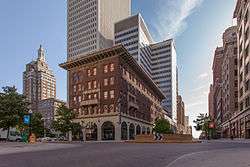 | |
|
Oil Capital Historic District in Tulsa, looking East along 5th Street from Main Street intersection | |
| Location | Tulsa, Oklahoma |
|---|---|
| Built | 1910-1967 |
| Architect | multiple |
| Architectural style | multiple |
| NRHP Reference # | 10001013 |
| Added to NRHP | December 13, 2010 |
The Oil Capital Historic District (OCHD) is an area in downtown Tulsa, Oklahoma that commemorates the success of the oil business in Tulsa during the early 20th century. During this period, Tulsa was widely known as "The Oil Capital of the World." The area is bounded by 3rd Street on the north and 7th Street on the south, Cincinnati Avenue on the east and Cheyenne Avenue on the west.[1]
Early in the 20th Century, Oklahoma emerged as a major producer of oil and gas. Many of the companies that would become notable in the energy industry located either their home offices or major regional offices in Downtown Tulsa, often constructing architecturally significant buildings to house them. Supporting companies such as equipment suppliers, banks, insurers, utilities and even hotels quickly followed suit. However, in the late 1960s and early 1970s, when the domestic oil business began to decline and companies began consolidating in other cities, these former office buildings became surplus. Some buildings were converted to other functions, but some others were razed for parking lots or freeways. Tulsans who became concerned about the loss of these historic and cultural landmarks began to work on adapting them for newer and more economic functions. The creation of the Oil Capital Historic District was implemented as a way to slow the losses while the plan was realized.
Building classifications
As part of the application process, all of the significant buildings within the proposed district boundaries were labeled as either "Contributing" or "non-contributing". Buildings in the former category had to meet certain criteria:
- Built between 1910 and 1967;
- Involved in some aspect of the oil business during that time;
- Had not lost their historical character through remodeling or conversion to other uses
The application states that the district contains 72 resources (69 buildings, 2 sites and one object). These were further classified as 40 contributing, 18 non-contributing and 14 which had previously been listed in the National Register.[1]
The table presented here identifies the buildings contained by the OCHD, as defined in the NRHP application. Data are largely derived from text descriptions in the application.They are listed by street address, beginning in the northeast corner of the district (3rd Street and Cincinnati.Avenue). Several architectural styles are represented in the district: Art Deco, Beaux Arts, Classical Revival, Commercial Style, Greek Revival, Italianate, and Modern Movement. Some buildings do not conform to any particular style.
| Name | Address | Year Built | Architectural Style | Notes |
| Parker Building | 8 East 3rd | 1929 | Gothic Revival | Non-Contributing |
| 24 East 3rd Building | 24 East 3rd | 1953 | Modern Movement | Contributing |
| Wright Building | 115 West 3rd | 1922 | Classical Revival | Contributing |
| Castle Building | 116 West 3rd | 1925 | Classical Revival | Contributing |
| Tulsa Federal Employees Credit Union Building | 120 West 3rd | 1971 | Modern Movement | Non-Contributing |
| Wright Building Annex | 115 West 3rd | 1916 | Commercial Style | Contributing |
| Reunion Building | 9 East 4th | 1919 | Classical Revival | Contributing |
| Mid-Continent Parking Garage | 117 East 4th | 1955 | No distinctive style | Non-Contributing |
| Tulsa Municipal Building | 124 East 4th | 1917 | Greek Revival | Contributing; previously listed as NRIS #75001574 |
| Tulsa World Building | 23 West 4th | 1917 | Greek Revival | Contributing |
| Tulsa World Annex | 23 West 4th | 1970 | Classic Revival | Non-Contributing |
| Irving Building | 110 West 4th | 1925 | Art Deco | Contributing |
| Downtowner Motel | 121 West 4th | 1961 | Modern Movement | Contributing |
| Sinclair Building | 6 East 5th Street | 1917 | Beaux Arts | Contributing |
| McFarlin Building | 9 East 5th Street | 1918 | Italianate | Contributing; previously listed as NRIS #79002030 |
| First National Tower/Chase Bank (now First Place Tower) | 15 East 5th Street | 1949 | Modern Movement | Contributing |
| Vandever Building | 16 East 5th Street | 1920 | Classical Revival | Contributing |
| Thompson Building | 20 East 5th Street | 1924 | Classical Revival | Contributing |
| University Club Building | 114 East 5th Street | 1924 | Classical Revival | Contributing |
| Tulsa Club Building | 115 East 5th Street | 1927 | Art Deco | Contributing |
| Mayo Building | 5 West 5th Street [lower-alpha 1] | 1915 | Classical Revival | Contributing; previously listed as NRIS #08001152 |
| Gillette-Pythian Building | 19 West 5th Street | 1930 | Art Deco:Zigzag | Contributing; previously listed as NRIS #82003703 |
| Petroleum Building | 111 West 5th Street [lower-alpha 2] | 1921 | Classical Revival | Contributing; previously listed as NRIS #82003706 |
| Mayo Hotel | 115 West 5th Street | 1925 | Classical Revival | Contributing; previously listed as NRIS #80003303 |
| Service Pipeline Building | 119 East 6th Street | 1949 | Art Deco/Streamline Zigzag | Contributing |
| Public Service Co. of Oklahoma Building | 2 West 6th Street | 1929 | Art Deco: Zigzag | Contributing; previously listed as NRIS #84003443 |
| Fourth National Bank Building | 15 West 6th Street | 1967 | Modern Movement | Contributing Now renamed Bank of America Center |
| Holiday Inn/Downtown Plaza | 17 West 7th | 1965 | Modern Movement | Contributing |
| 320 South Boston Building/ Exchange National Bank/ National Bank of Tulsa | 320 South Boston Avenue | 1917 & 1928 | Beaux Arts | Contributing |
| Kennedy Building | 321 South Boston Avenue | 1918 | Beaux Arts | Contributing |
| 400 South Boston Avenue | 400 South Boston Avenue | 1967 | Modern Movement | Contributing |
| Cosden Building/Mid-Continent Tower Building | 409 South Boston Avenue | 1918 & 1984 | Gothic Revival | Contributing; previously listed as NRIS #792002029 |
| 410 South Boston Avenue Building | 410 South Boston Avenue | 1974 | Modern Movement | Non-Contributing |
| Atlas Life Building | 415 South Boston Avenue | 1922 | Classical Revival | Contributing; previously listed as NRIS #09000358 |
| Philtower Building | 427 South Boston Avenue | 1927 | Classical Revival | Contributing; previously listed as NRIS #79002032 |
| Philcade Building | 501 South Boston Avenue | 1930 | Art Deco: Zigzag | Contributing; previously listed as NRIS #86002196 |
| Day Building | 514 South Boston Avenue | 1925 | Commercial Style | Contributing |
| Fawcett Building | 515 South Boston Avenue | 1934 | Art Deco: PWA | Contributing |
| Pan American South Building | 519 South Boston Avenue | 1967 | Modern Movement | Contributing |
| 522 South Boston Avenue Building | 522 South Boston Avenue | 1954 | Modern Movement | Non-Contributing |
| 601 South Boston Avenue | Parking Garage | 1954 | No distinctive style | Contributing |
| 616 South Boston Avenue Building | 616 South Boston Avenue | 1951 | Moderne | Contributing |
| Oklahoma Natural Gas Company Building | 624 South Boston Avenue | 1928 | Art Deco: PWA | Contributing; previously listed as NRIS #84003458 |
| Ponca City Savings and Loan Building | 633 South Boston Avenue | 1956 | Modern Movement | Contributing |
| Masonic Temple | 706 South Boston Avenue | 1923 | Beaux Arts | Contributing |
| First Presbyterian Church | 709 South Boston | 1926 & 1953 | Gothic Revival | Contributing |
| United States Post Office and Courthouse | 224 South Boulder Avenue | 1917 & 1934 | Classical Revival | Contributing; previously listed as NRIS #00000244 |
| 320 South Boulder Avenue Building | 320 South Boulder Avenue | 1917 | No distinctive style | Non-Contributing |
| Beacon Building | 406 South Boulder Avenue | 1923 | Beaux Arts | Contributing |
| Petroleum Club | 601 South Boulder Avenue | 1965 | Modern Movement | Contributing |
| Mid-Co Building | 302 South Cheyenne Avenue | 1918 | Beaux Arts | Contributing |
| Mincks-Adams Hotel | 403 South Cheyenne Avenue | 1928 | Mixed Style | Contributing; previously listed as NRIS #78002273 |
| 308 South Cincinnati Avenue | 308 South Cincinnati Avenue Building | 1919 | No distinctive style | Non-Contributing |
| 414 South Cincinnati Avenue Building | 414 South Cincinnati Avenue | 1965 | No distinctive style | Contributing |
| University of Tulsa Law School | 512 South Cincinnati Avenue | 1949 | Art Deco: Streamline/Zigzag | Contributing |
| 610 South Cincinnati Avenue | 610 South Cincinnati Avenue Building | 1959 | Modern Movement | Contributing; |
| 309 South Main Street Building | 309 South Main Street | 1930 | No distinctive style | Non-Contributing |
| Renberg Building | 311 South Main Street | 1947 | Modern Movement | Contributing |
| 312 South Main Street Building | 312 South Main Street | 1970 | Modern Movement | Non-Contributing |
| Drexel Building | 317 South Main Street | 1910 renovated c. 1950 | No distinctive style | Contributing |
| Palace Building | 324 South Main Street | 1913 | Art Deco: Zigzag | Contributing |
| Parking Garage | 402 South Main Street | 1975 | No distinctive style | Non-Contributing |
| 502 South Main Street Building | 502 South Main Street | 1981 | Modern Movement | Non-Contributing |
| Ketchum Hotel/Oil Capital Building | 507 South Main Street | 1915, renovated in 1947 | Commercial Style | Contributing |
| 515 South Main Street Building | 515 South Main Street | 1986 | Modern Movement | Non-Contributing |
| 525 South Main Street Building (Park Centre Building) | 525 South Main Street | 1973 | Modern Movement | Non-Contributing |
| 610 South Main Street Building | 610 South Main Street | 1929 | Beaux Arts | Contributing |
| 616 South Main Street Building | 616 South Main Street | 1929 | Beaux Arts | Contributing |
Oil Industry decline
The importance of Tulsa in the oil industry, as well as the impact of the oil industry on Tulsa, declined as the United States began to rely more heavily on cheaper offshore and imported oil. Major international companies downsized or eliminated their Tulsa offices and moved to cities nearer the coasts, especially after foreign countries began exerting more control over their own oil resources. The Arab Oil Embargo accelerated the trend. The International Petroleum Exposition, which had drawn a record number of visitors in 1966, faded in importance and occurred less frequently until it was permanently cancelled after the 1979 show.[2]
District buildings demolished 1967-2010
Notable buildings in or very near the OCHD that were demolished during the decline of the oil business and the creation of the district include:
- Bliss Hotel 2nd & Boston, Built in 1929 and razed in February 1973.[3]
- Hunt Building, 4th and Main, better known as the Brown-Dunkin Department Store, demolished in 1970.[3]
- Medical Arts Building 6th and Boulder. Demolished July 1970.[3]
- Hotel Tulsa, 3rd and Cincinnati. Demolished 1972.[3]
- Skelly Building, 23 West 4th, A 9-story office of the Skelly Oil companies, demolished.[4]
- Orpheum Theater, 12 East 4th Street, opened in 1917 as a vaudeville theater, then switched to movies in 1931. Closed in March 1970 and was demolished in May 1970.[5][6] It was replaced by the Tulsa Building & Loan Building at 10-12 East 4th.(originally the Edwards Building, built in 1926.)[7]
Current status of selected surviving buildings
First Place Tower
This building was completed in 1973 and previously housed, in succession, the First National Bank of Tulsa and a Citicorp branch. Citicorp vacated the premises in 2012. ONE Gas, Inc. planned to move its headquarters to this building in 2014.[8]
Sinclair Building
According to a Tulsa World article, a Tulsa County District Judge ruled that the City of Tulsa and the Central Park Owners Association Inc. could foreclose on the Sinclair Building because the current owner was in arrears on $270,000 for taxes, fees and penalties. The sale could be sold at a sheriff's auction, after a 30-day appeal period, unless the owner reaches a settlement agreement with the city and other creditors.<ref name=Sinclair"Bankruptcy">Canfield, Kevin. "Tulsa's historic Sinclair Building could soon be sold at auction." Tulsa World. June 3, 2014. Retrieved June 24, 2014.</ref>
Tulsa Club Building
The Tulsa Club was founded in 1925 as a social club for wealthy businessmen. The 11-story building, designed by Bruce Goff, was constructed in 1927 on the northwest corner of Fifth Street and Cincinnati Avenue, next to the Philtower Building. The Tulsa Chamber of Commerce owned 40 percent of the building and the club owned 60 percent. The Chamber of Commerce and other organizations used the lower five floors, while the Tulsa Club occupied the top six and a roof garden. The chamber sold its interest to the club in 1952, when it built a new building at 616 South Boston. The club abandoned the building in 1994.[9]
It is unclear when California investor C. J. Morony acquired the building. It is even less clear why. Space was never rented, but the building was allowed to deteriorate. Squatters moved and several fires were deliberately set inside. The city tried for seven years to get him to correct code violations, pay delinquent taxes and fees.[10]
Bruce Garrett bought the building for $400,000 in April 2013 at a sheriff's sale. He has announced plans to renovate it, while preserving the early 20th Century design.[11]
633 South Boston Building
This building was designed by architect Robert Buchner to house the Tulsa office of Ponca City Savings and Loan Company, but has remained vacant for a number of years. The Tulsa Foundation for Architecture was interested in acquiring the building, intending to create a museum of blueprints and other drawings. However, the foundation was unable to raise sufficient funding and the idea was dropped.[12]
8 East 3rd Street Building
The 10-story building at 8 East 3rd Street has been named as the Holarud Building, the McBirney Building and the Parker Building.[13] It was constructed in 1929 as the headquarters for Parker Drilling Company, and was known as the Parker Building. The company extensively remodeled it in 1975, then sold it and relocated to Houston in 2001. Apparently the building remained vacant until Parker Drilling Company reacquired it in 2012, as a result of foreclosure. The company then sold the building to the Anish Hotel Group, who announced that the building will be converted into a hotel. Since the recent sale, it has been renamed as the 8 East 3rd Street Building.[14]
As of March 2014, the 3rd Street Building project was on hold. Because a large number of hotel projects were being considered for Downtown Tulsa, some concern have arisen about whether there would be sufficient demand for all these to survive. In an interview, Anish Hotel Group founder, Andy Patel, said that the company is also thinking about converting the former Parker Building to residences or office spaces.[15]
Palace Building
Also known as the Excaliber Building and the 324 South Main Building, the structure was reportedly owned by the Tulsa World in 2012. For several years, it had been vacant, except for an Arby's restaurant on the ground floor. Rumors that the building would be demolished were denied by the newspaper.[4]
Petroleum Club Building
The Petroleum Club Building at 601 South Boulder in Tulsa got its name from the private club that moved into its top three floors when it was built in 1963. The building is 196 feet (60 m) tall, has 14 stories, and contains 118,000 square feet (11,000 m2) of floor space. In 1994, a major fire heavily damaged the top two stories, forcing the club to close, and causing serious smoke damage throughout the rest of the building. The club facilities were rebuilt and the facility remained open until 2011. The decline of the oil business in Tulsa was accompanied by a loss of members in the club, and contributed to heavy financial losses. The club closed in July 2011. However, the building is still referred to locally as the Petroleum Club Building.[16]
Gallery
Street views
-

Looking north on Boston Avenue from 6th Street intersection
-

Looking north east between Main Street (left) and Boston Avenue (right). Philtower is right of center; Thompson Building is left of center; Mid-continent Building is behind the Philtower. Photo in 2008 by Caleb Long.
-

Several buildings in downtown Tulsa, Oklahoma. Philtower: Orange top, brick building in the center foreground; Mid-Continent Tower: to the right of Philtower with the greenish roof; First Place Tower: to the left of Philtower.
Contributing buildings
-

former National Bank of Tulsa now a general office building
-

converted to mixed office and residential building
-

515 South Boston
formerly Amoco and Stanolind Buildings -

401 South Boston
original 20-story building expanded in 1984 to present height -
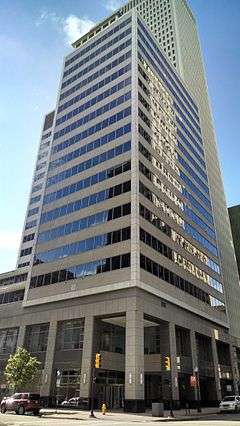
First National Bank, 5th Street & Boston Avenue
-

Mincks-Adams Hotel (later known as Adams Hotel)
403 South Cheyenne Avenue -
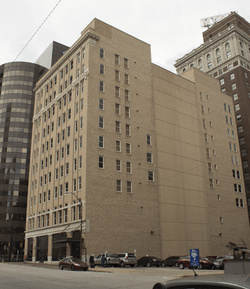
Petroleum Building
111 West 5th Street -

Mayo Building
420 S. Main -

Atlas Life Building|Former Atlas Life Building (converted to a hotel)
-

Thompson Building
-

Sinclair Building
6 East 5th Street -

Tulsa World Building
-

Public Service of Oklahoma Building
2 West 6th Street -
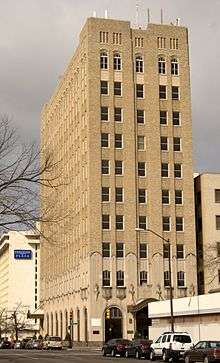
Former ONG Building
-

Bank of America Center
(Formerly 4th National Bank) -

Former main post office
-
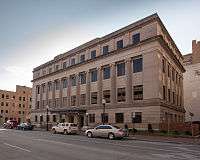
Former Tulsa Municipal Building
115 East 4th Street -

Oklahoma Natural Gas Co. Building
624 South Boston Avenue
Non-contributing buildings
-

Park Centre Building (1973)
525 Main Street -

Former Mayo Hotel Garage
Additional information
National Register of Historic Places Registration Form Retrieved June 19, 2014. (Also available here.)
Notes
References
- 1 2 National Register of Historic Places Registration Form for Oil Capital Historic District. Retrieved June 19, 2014.
- ↑ Weaver, Bobby D. Encyclopedia of Oklahoma History and Culture. "International Petroleum Exposition." Retrieved May 7, 2014.
- 1 2 3 4 "Urban Renewal - What we lost." Tulsa Gal blog. March 10, 2010. Retrieved July 18, 2014.
- 1 2 Excaliber Building won't be demolished, Tulsa World says." Wall, Holly. This Land Press. May 17, 2012. Retrieved July 18, 2014.
- ↑ "Forgotten Tulsa Orpheum Theater." June 29, 2008. Retrieved July 18, 2014.
- ↑ "Cinema Treasures: Orpheum Theater." Retrieved July 18, 2014.
- ↑ Emporis. Tulsa Building & Loan Building. Retrieved July 18, 2014.
- ↑ Evatt, Robert. "CBRE sues Kanbar Properties." Tulsa World. June 5, 2014. Accessed December 23, 2015.
- ↑ "Abandoned Oklahoma: Tulsa Club Building." Retrieved June 24, 2014.
- ↑ "Tulsa Club owner Josh Barrett vows to remake historic building." Tulsa World. September 18, 2013. Retrieved June 24, 2014.
- ↑ "Man hopes to restore Tulsa Club Building to former glory." Terrell, Ron. Fox23.com. December 31, 2013.
- ↑ "Historic Ponca City Savings and Loan building finds new purpose." Overall, Michael. Tulsa World. June 11, 2014. Retrieved June 25, 2014.
- ↑ "Emporis: Holarud Building." Retrieved June 28, 2014.
- ↑ "Former Parker Drilling building sold to hotel group." Evatt, Robert. Tulsa World. October 25, 2013. Retrieved June 28, 2014.
- ↑ "Building on demand: Patel plots Anish expansion in Stillwater, more hotels for Tulsa area." Davis, Kirby Lee. The Journal Record. March 3, 2014. Retrieved June 28, 2014.
- ↑ "Petroleum Club falls short in effort to keep doors open. Walton, Rod. Tulsa World. July 6, 2011. Retrieved November 19, 2014.